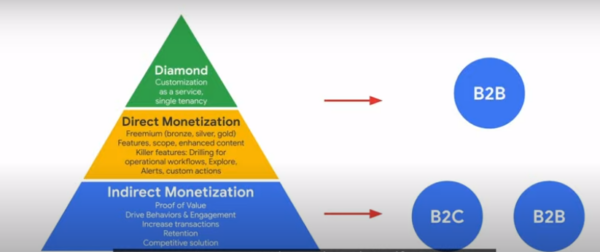M+E Connections

Google: How to Use Embedded Analytics to Monetize Data
Story Highlights
Embedded analytics can be used by organizations to not only monetize data but also to build new revenue streams by charging third parties for indirect or direct access to insights through data-driven “nudges” that drive business, according to Google.
Embedded analytics can also connect suppliers and customers through data products augmented with context, insights and actionability, Skander Larbi, head of solutions, embedded analytics, at Google, said July 27 during the webinar “Data Monetization with Embedded Analytics.”
Another use for embedded analytics: enriching and productizing data with best practices and customer success stories.
The webinar was the last in a three-part Google workshop series on business intelligence.
During the informative and practical session Larbi provided demonstrations and later fielded questions from participants viewing online.
 Larbi, who said he joined Google Cloud in 2017, said at the start of the webinar that he was going to “talk about data monetization and the business model of going to market with data.”
Larbi, who said he joined Google Cloud in 2017, said at the start of the webinar that he was going to “talk about data monetization and the business model of going to market with data.”
“By using an embedded analytics platform so [that] customers can be self-sufficient and data-driven, but also harness the value displayed on the screen,” he noted.
“When it comes to data modernization, what we’ve noticed over the course of the past few years [is] that most companies are focusing only on the insights,” he pointed out. “Most companies are focusing on the business value. So basically turning data into information and using BI tools, dashboards and reports. So really this is, I would say, level one.”
He continued: “The second level is a little bit more mature, when companies start optimizing these insights. Optimizing means they’re automating those insights. there’s going to be value chain integration. They start injecting some data science workflow, some predictions. Basically they’re becoming more agile with the data intelligence and they don’t necessarily need, I would say, smart workers to review the insights.”
He added: “A lot of the decisions [are] automated,” predicting that, “in the next [few] years, most companies are going to be focusing on taking this data, not internally, but using this data as a product in order to be monetized.”
He recalled that, “when we were talking with all our customers and when we were identifying all the use cases of all the best companies in the world that are monetizing this data, we identified that actually there only three ways of monetizing data.”
That could be seen in a pyramid Google created that he showed viewers. “At the bottom, you can see what we call indirect monetization. I believe indirect modernization is one of the most powerful go-to-market ways of monetizing data. Why? Because [organizations should have] insights into your product and basically orchestrating the entire product lifecycle of any product, any website, any web application.”
He explained: “What I mean by proof of value [is] you’ll be able to use insights to acquire customers, to engage with your customers, retain them. But, most importantly, you’re also converting them to some transaction or to some up-sales or any sorts of conversion.”
Second on the pyramid is direct monetization, which he said “really consists [of] packaging your data product. It could be a payment wall, it could be a be a tiered offer where you’re going to have different data product.”
He added: “It’s competitive insights. You’re going to have benchmark insights, sales insights and really productizing, packaging it with features [and a] different level of values and insights.”
The third level of the pyramid is called “Diamond,” he said, adding it is, “I would say, a combination of the indirect and direct. [It] is when your customers, probably the most advanced customers you have, will need more capabilities. They will ask you for self-service data. They will ask you for not only insights. They will probably ask you to ingest these insights into their warehouse. They will also probably need services and some expertise and subject matter expertise.”









